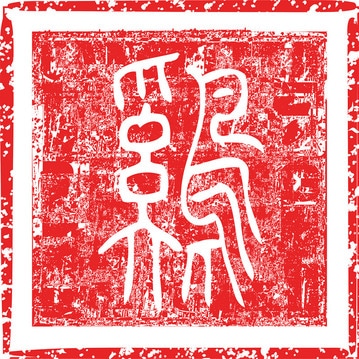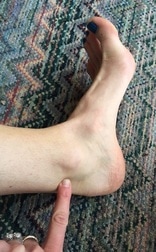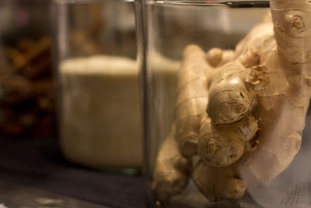 2017 is finally upon us and Today, January 28th, marks the year of the Fire Rooster in Chinese Astrology. The rooster's astrological traits include loyalty, hard work, a focus on family values, commitment and an emphasis on appearance. This means that attention given to these areas in the Year of the Rooster can reap rewards - a perfect year for Facial Acupuncture in particular! The Rooster is also confident and sure, meaning middle of the road doesn't cut it. Much like Yoda, the Year of the Fire Rooster is a "do or do not, there is no try" kind of year. In the Year of the Rooster it is worthwhile to carefully consider your options and to be clear and focused with your intentions. This also means that in the Year of the Rooster, the strong energy of "DO" can support you in achieving goals that you may have struggled with in the past. So if you feel ready for a change, this is a great time to commit and stick to it. To prepare for the Year of the Rooster, I highly recommend taking a moment to reflect and plan. Are there projects you've been waiting to do? Changes in your health and life that you want to make? There are still 3 weeks until the 28th which you can use to gather information and think about what you might want to achieve. To help you make the most of your health and wellness goals in the Year of the Fire Rooster, I am offering my semi annual 3 treatment special from today through the end of February. I am now including Facial Rejuvenation Acupuncture packages in my discount as well! A perfect way to put your best face forward in the lunar new year! You can purchase 3 treatment packages for yourself or others using the "gift certificate" link in the drop down menu above or by clicking on the button below. Its a limited time offer, don't delay!  Kidney 3, also known as the Great Valley is a superstar acupoint for many reasons. Located on the inside of the ankle, in the depression between the medial malleolus and the tendo calcaneus, this point is aptly named because it is located in the valley between the achilles tendon and the malleolus. The tibial artery can even be considered a “stream” running through the valley. Kidneys would include the kidney-urinary system, as well as the endocrine system. The kidneys would also be where you would find the adrenals. In Traditional Chinese Medicine, the kidneys are also the storehouses of our Qi and have a direct relationship to reproduction and aging. Locally this point can be used for heel and ankle pain, including plantar fasciitis. For reproduction, the kidneys are essential for sperm and egg health and Kidney 3 can help with impotence as well as irregular menstruation and endometriosis. For urinary health it can treat nighttime urination issues, as well as incontinence, chronic cystitis, frequent urination and even dry stools! The kidney is related to the lungs and Kidney 3 can work for certain types of asthma, especially when there are issues taking deep breaths. It can help alleviate coughing as well as reduce wheezing. The kidney meridian has an internal branch that goes to the throat and Kidney 3 can be indicated for sore throats, dry mouth, throat, cough and laryngitis. On a more emotional and spiritual level, Kidney 3 can help when there is an imbalance between the kidney and heart in cases of anxiety, insomnia, dream-disturbed sleep and forgetfulness. For imbalances with the liver and kidney yin, this point can help with irritability. For people who need to be grounded, Kidney 3 can be combined with Stomach 36 (just below and lateral to the knee) for a very calming effect. Feel free to ask for Kidney 3 at your next Acupuncture session if the actions and indications above resonate with you. If it sounds good, it probably is!  Traditional Chinese Medicine views things differently than other medical systems. In TCM, there are guidelines that are considered very logical when it comes to the seasons. These guidelines lay out what foods and activities are best for each season of the year. Chinese medicine teaches us to live in harmony with the seasons. In TCM, there are actually five seasons – summer, late summer, fall, winter and spring. Every season has many associations which help guide people to create a more balanced life. When TCM was being developed, people lived in harmony with nature and they lived healthy, balanced lives. In modern society, we have gotten away from our connection with nature and we have many more distractions that have ultimately led us to become unbalanced and unhealthy. Winter represents the most yin aspect of Chinese medicine. The properties associated with yin include darkness, cold, slow movement and inward energy. Winter is associated with the kidneys in TCM. The kidneys hold the body’s fundamental energy or Qi. By balancing ourselves with the corresponding seasons, we can prevent disease and stay healthy. So for the season of winter, we should take note of what happens in nature and do the same. To keep the kidneys strong, we must rest. This is why many animals hibernate during the winter. It is also a time to reflect inward and perform activities such as meditation, tai chi and qigong. These are the kinds of practices that help us connect with our inner selves and also support kidney energy. When it comes to foods most beneficial for the body during the winter months, there are many to choose from. These should also be ones that naturally grow during this season. Items such as squash, potatoes, pumpkin, sweet potato, cinnamon, nutmeg, cardamom, beets, greens, carrots, mushrooms, apples, pears and cabbage. During the winter months, cold foods like salads and raw foods should be avoided as they will deplete the immune system. Instead, our bodies need warming foods like soups made with hearty vegetables. Bone broth is also very beneficial and becoming more mainstream. There are also foods that specifically target and nourish the kidneys. These include kidney beans, beef, goose, duck, black beans, lamb, chicken, dark leafy greens, garlic, ginger, walnuts, watercress and turnips. Sea salt is also helpful. Salty is the taste associated with the kidneys. But as with anything, moderation is key. Too much salt can actually tax the heart, which then causes the kidneys to work overtime. You should cook for longer periods of time and on low heat with less water, so things like stews are perfect for this time of year. The longer cooking times will infuse the foods with more heat, which will help keep the body warm. It is recommended to bake, roast, stew and slow cook foods in the winter. Hearty soups, roasted nuts and whole grains should be consumed when possible because they offer nourishment that feeds the body as well as the kidneys specifically. By taking cues from nature and ancient healing practices, better balance can be achieved and health can be maintained. Those that went before us may not have known everything, but they did know how to survive or we would not be here today. Trusting the teachings of our ancestors will allow us to continue to survive also. Happy Winter Eating!  While the flu is actually not a season, we have become programmed to think of it as the months of November through March. On average, the flu hospitalizes thousands every year, especially the young and elderly. There are also a number of deaths related to the flu, mostly due to people already having compromised immune systems. The flu, also known as influenza, is a highly contagious respiratory infection that is caused by a number of viruses. To date, there are approximately 26 to 30 different known strains of the flu virus. This is one of the reasons the flu vaccine has only mild efficacy. The flu vaccine itself, typically only covers five to seven strains of the flu. Symptoms of the flu include fever, coughing, a sore throat, fatigue, muscle aches, pains, runny nose and watery eyes. The good news is we can avoid the flu by implementing healthy habits and taking care of ourselves throughout the year. The best way to treat a disease is to avoid it. Traditional Chinese Medicine is a great tool to have in the toolbox for preventing the flu. Utilizing botanical Chinese formulas and acupuncture treatments can be very beneficial in keeping the flu at bay. Regular acupuncture treatments help boost immunity, while balancing and regulating the body’s energy or Qi (pronounced “chee”). Several studies have shown acupuncture can reduce the incidence of upper respiratory tract infections and shorten the length of time that somebody is ill. TCM botanicals or herbs are also a great way to ward off the flu bug. Two herbs in particular are specified for strengthening Qi and boosting the immune system. The first is huang qi or astragalus and the other is dang shen or codonopsis. There are a couple of other herbs commonly used as antivirals too. These are ban lan gen (isatis root) and da qing ye (isatis leaf). Along with TCM, there are other things we can utilize to avoid catching the flu. Regular exercise, ample sleep and a proper healthy diet are two of the best things anybody can use to stay disease-free. Exercising enough to break a sweat without overdoing it has been shown to reduce the incidence of the flu. So incorporating practices like tai chi, qi gong and yoga can actually reduce physical and emotional stress, while strengthening the immune system and preventing disease. Eating a healthy diet is essential for preventing any disease, not just the flu. This includes eating a very balanced diet rich in vitamins, minerals and antioxidants. Foods that contain beta-carotene are especially helpful at boosting the immune system. Carrots, broccoli, sweet potatoes and garlic are good examples of beta-carotene rich foods. Also drinking at least 64 ounces of water on a daily basis is highly recommended. Ample fluid intake helps the body flush out invaders and toxins, while keeping the mucus membranes and upper respiratory tract healthy enough to fight off the virus. Taking advantage of what TCM can offer, while incorporating healthy daily habits will insure this upcoming flu season passes by without wreaking havoc on any of us!  Large Intestine 4 is one of the most important and influential points in the entire body. The Chinese name for Large Intestine 4 is “He Gu” meaning union valley or converging valley. The point is located on the hand in the web between the thumb and index finger, also described as the depression where the index finger and thumb bones part. This area of the hand is often described as “valley like” hence the name converging valley. The large intestine has many important functions in the body. Connected to the Western medicine function of the large Intestine, it is vital in digestion and bowel regulation, but it also has many functions above and beyond that in Chinese medicine. The large intestine is associated with the emotions of sadness and grief, it can help build immunity as it works as a paired channel to the lung meridian and has a big effect of the flow of Qi and blood in the body. Large Intestine 4 is a strong point for building the immune system and can be used for when someone has a cold or the flu. It can be used to treat febrile illnesses, rashes from wind or heat, allergic reactions causing rhinitis, as well as sore throat and difficulty swallowing. It is the command point of the face, nose, jaw and mouth and can be used to treat many problems associated with those. Toothaches and TMJ can be painful, but Large Intestine 4 can reduce the pain without even going near the affected areas. It is one of the main points for headaches and many people instinctively press it on their hand when they have a headache, without even realizing it is an acupuncture point. If someone has suffered a stroke, this point can help with paralysis and aid in recovery. The large Intestine has a great effect on the flow of qi and blood in the body and Large Intestine 4 is a very strong point to get everything moving. Pain, in Chinese medicine, is often when the Qi and blood are stuck and Large Intestine 4 is critical to move this stagnation, especially when coupled with another point called Liver 3. Together, this pair of points is called The Four Gates and together they are a powerhouse in getting the Qi and blood circulated. They can effectively treat pain, depression, constipation, promote labor, expel retained placenta and help alleviate menstrual disorders caused by stagnation such as endometriosis. Large Intestine 4 is contraindicated in pregnancy because it is so powerful and moving, but it can be effectively used to induce labor. Used in conjunction with another powerhouse acupuncture point Spleen 6, these two points are commonly used together to start labor, often with electroacupuncture to stimulate the points even more than needles alone. Once labor has started, Large Intestine 4 can be used if labor is stalled or prolonged as well as used after childbirth to expel the placenta, decrease postpartum bleeding and decrease the time between childbirth and the discharge of the placenta. Large Intestine 4 is an exceedingly influential point and one of the most commonly used points in acupuncture treatments. It can also be effective in treating a range of emotional issues such as depression, insomnia, stress, irritability and severe PMS. This point should not be underestimated and its alternative name of Tiger's Mouth is barely descriptive of its strength in acupuncture treatments. |
AuthorsRebecca M H Kitzerow is a Licensed Acupuncturist practicing in La Center, Washington. With over a decade of experience she has won 10 Nattie consumer choice awards from Natural Awakenings Magazine since 2014. Archives
July 2024
Categories
All
|
Photos from Hey Paul Studios, BeGreen_Studio, Pawel Pacholec, 1950sUnlimited, toulupaliaqaz, Joelk75, OnTask, Robert Gourley, cnu_sports, Mitya Ku, wuestenigel (CC BY 2.0), FootMassagez, 401(K) 2013, Mariana Heinz, @EdwardTerry, fishhawk, liverpoolhls, torbakhopper, Boemski, dolomitibl, Driscolltheque, Dave n Laura, Vaping360, MVWorks, Life Mental Health, MVWorks, mikefats, Scot Nelson, jfl1066, wZa HK, ruurmo, Guadalupe Cervilla, Army Medicine, GViciano, torbakhopper, adrigu, Saulo Cruz, Ben Cumming, marniejoyce, kcxd, JasonCorey, kanenas.net, Live to Create Photography, gm.esthermax, Unique Hotels Group, Zenspa1, mysiana, Tobias Lindman, Leader Nancy Pelosi, Kristoffer Trolle, swanksalot, Bill Selak, Parker Knight, stimpsonjake, Gedankensprudler, SuperFantastic, tonynetone, marniejoyce, JeepersMedia, Illusive Photography, 'Ajnagraphy', Iban Torras, scotted400, gtall1, dvanzuijlekom, BPPrice, Skley, torbakhopper, Renato Ganoza, anka.albrecht, QUOI Media, Public Domain Photos, Instant Vantage, Victor Tongdee, Free Grunge Textures - www.freestock.ca, sportEX journals, Nadja Tatar, angela n., marniejoyce, MVWorks, Karolina Kabat, Thomas Fisher Rare Book Library, UofT, ginnerobot, tracilawson, haven't the slightest, My Photo Journeys, Pierre Willemin, Florena_Presse, SuperFantastic, colindunn, zzkt, TraumaAndDissociation, ER24 EMS (Pty) Ltd., shixart1985 (CC BY 2.0), marniejoyce, Tomás Fano, freestock.ca ♡ dare to share beauty, Archives New Zealand, Jaykhuang, airdrie.m, Go-tea 郭天, OnTask, wuestenigel, focusonmore.com, Disney | ABC Television Group, Andrew Gustar, Didriks, ConstructionDealMkting, charlywkarl, barnimages.com, Lel4nd, runwaypilates, michaelstephanfotografie, McLevn, TraumaAndDissociation, eLife - the journal, Lars Plougmann, wuestenigel, shixart1985, boviate, davis.steve32, kevin dooley, @the.photoguy (insta), frederic.gombert, Feathering the Nest, Victor Tondee, shixart1985, wuestenigel, Joe K Gage, kennethkonica
 RSS Feed
RSS Feed
